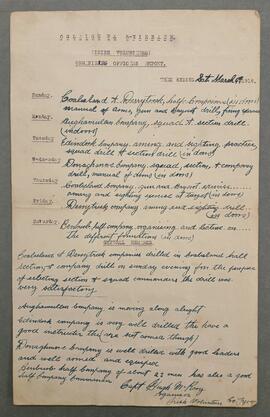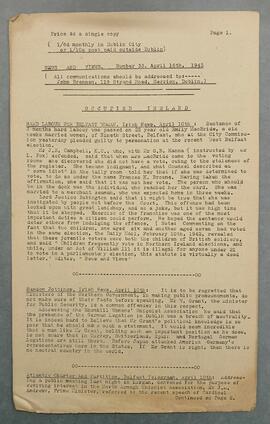A file containing four reports compiled by Captain Hugh McRory on Irish Volunteer gatherings, drills, rifle practice, and training in County Tyrone. The reports are dated 19 February, 26 February, 4 March, and 11 March 1916.
The subseries comprises material assembled by Fr. Senan Moynihan OFM Cap. for the 1937 edition of ‘The Capuchin Annual’ which included several articles exploring the life of the pietist Matt Talbot.
Talbot was born into a large working-class family in the North Strand area of Dublin in 1856. He left school at the age of twelve and subsequently worked as a labourer at the Port and Docks Board. From an early age, Talbot was an alcoholic. He frequented pubs in the city with his brothers and friends, spending most of his income on alcohol and running up considerable debts.
In about 1884, Talbot ‘took the pledge’ and renounced the consumption of liquor. He maintained sobriety for the following forty years of his life. He also began to attend daily Mass and assiduously read religious books and pamphlets. He collapsed and died of heart failure on 7 June 1925, whilst on his way to attend a religious service. His body was taken to Jervis Street Hospital, where the full the extent of his ascetic lifestyle was revealed. Attendants discovered a metal link chain wound around his torso, and lighter chains and knotted cords on the arms and below the knees. The latter likely caused discomfort when kneeling.
Talbot’s funeral took place in Glasnevin Cemetery on 11 June 1925. As word of his piety spread, Talbot became an icon for the temperance movement in Ireland and for the large Irish expatriate communities in Britain and in the United States. This rapidly developed into a substantial devotional movement, promoted by the clergy and by lay activists, with Talbot held up as a possible candidate for canonisation as a Catholic saint. In October 1975 Pope Paul VI declared him to be the Venerable Matt Talbot, an important step to canonisation.
Talbot’s remains were removed from Glasnevin Cemetery to Our Lady of Lourdes Church on Seán McDermott Street in 1972. The church has since become a site of pilgrimage. The Talbot Memorial Bridge, completed in 1978, was named in commemoration of the former dock worker. A statue of Talbot was also erected at the southern end of the bridge.
The subseries comprises a small collection of rare texts assembled by Fr. Senan Moynihan OFM Cap., the editor of ‘The Capuchin Annual’. Some of these books may have been acquired by Moynihan at auctions of rare documents and historical publications.
A collection of typescripts titled ‘News and Views / Occupied Ireland’ reporting on significant events in Ireland and especially in Ulster during the Second World War. The articles were seemingly taken are from contemporary newspapers. The typescripts were compiled by the republican journalist Sydney Madge Czira (née Gifford), better known by her pseudonym of ‘John Brennan’.
The sub-series contains a small collection of newspaper clippings connected with the life and ministry of Fr. Albert Bibby OFM Cap. Some of records refer to the death of Fr. Albert in February 1925 and tributes and commemorations thereafter.
This sub-series comprises correspondence with the widows of two executed leaders of the 1916 Rising, Lillie Connolly and Muriel MacDonagh
The sub-series contains a collection of mostly personal papers relating to the life and ministry of Fr. Dominic O’Connor OFM Cap. The section includes some papers relating to his interest in the history of the Capuchins in Ireland and some newspaper clippings published after his death.
Some Irish Capuchins displayed a noticeable sympathy with the republican interest during the Civil War. The Church Street community maintained close ties with various republicans including Frank Gallagher who carried out propaganda work on various Anti-Treaty bulletins, newsletters and publications. Gallagher worked alongside Erskine Childers (who was also on good terms with some Capuchin friars) on the republican publicity staff. Both men sided with Éamon de Valera in the Treaty debates. Gallagher and Robert Brennan were significant contributors to the 'Daily Bulletin' which was produced at this time (See CA IR/1/8/3/8). As a consequence, most of the tracts and publicity material obtained by the Capuchins reflected a rigidity to the Sinn Féin version of the conflict and demonstrated an implacable hostility to the Treaty and its supporters.
The extensive and often lavish use of photographs in 'The Capuchin Annual' set the publication apart from many other periodicals of the time. Photography in the 'Annual' served a very clear purpose – it projected an idealised image of Ireland to its wide readership in a way that was arguably more effective than any prose. In the early years, scenic views such as ‘Evening in Dublin’ or ‘Killiney Bay’ would appear randomly, but in later years photographic features became far more extensive. The 'Annual’s' photographic archive is particularly rich and constitutes a valuable pictorial record of life in Ireland in the twentieth century.

